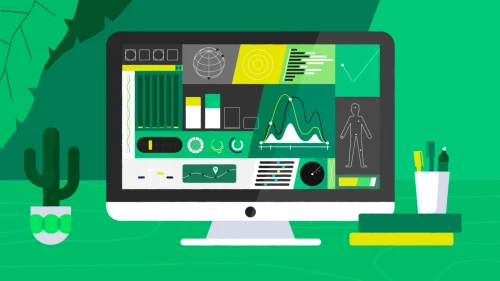Digital marketing presents a tremendous opportunity to engage consumers, but precious few companies have realized its full potential. That’s not to say companies aren’t trying. In the US, spending on digital advertising in 2017 is on track to surpass spending on television advertising. Globally, certain markets devote more than 40% of their media advertising budget to digital marketing, according to media company Magna.
But supersizing the digital-marketing budget is not enough. Successful companies are also transforming their ways of working. Classic marketing techniques—including broad segmentation, lockstep campaigns with multiple handovers, and marketing funnels through which all consumers move in tandem—have no place in digital marketing. If your company is still relying mainly on ways of working that served you well ten years ago, it is time to accelerate change.
So what is working in digital marketing today? Leading companies are capitalizing on three forces that have fundamentally changed the way marketing can be done:
- Access to large quantities of real-time data to inform their campaigns
- Ability to engage in long-term, omnichannel relationships with consumers (as opposed to one-way, scattershot interactions)
- Flexibility to deploy multiple concepts and gather real-time feedback from customers
BCG and Facebook teamed up with leading companies across a wide variety of industries to apply cutting-edge digital marketing techniques to a specific business challenge. We share examples of companies that have launched successful digital-marketing efforts and highlight the changes that companies need to make in order to capture the extraordinary value that digital marketing has to offer.
Why Change Now?
The ways in which consumers engage with media have shifted dramatically in recent years—and marketing approaches must be reinvented accordingly. It helps to understand the new environment.
Consumer behavior is changing fast. The younger generation, in particular, has all but abandoned print newspapers and magazines in favor of digital media—and broadcast television is losing ground as well. It’s not that people are spending less time consuming media. On the contrary, media consumption has risen in recent years. People are just spending less time consuming traditional media. In Europe, according to Statista, overall viewing climbed from 44 hours per week in 2009 to 48 hours in 2015, but traditional media lost ground by 2.5 hours while digital consumption increased by 6.5 hours. Facebook data shows that in the US, the average person now spends approximately 60 minutes each day on Facebook, Instagram, and Messenger.
Consumers are also more digitally savvy and increasingly impatient with traditional marketing techniques and intrusive or irrelevant content and messages. More than 25% of all smartphone users have installed ad blockers, according to eMarketer, and that figure is climbing rapidly. When selecting new products and services, consumers rely more than ever on advocacy from people they know and trust. Personal recommendations are now five times more trusted than brand marketing, according to the Word of Mouth Marketing Association.
Advertisers are following consumers online. Although total ad spending is still growing slightly ahead of GDP, much of this growth is in digital advertising. Globally, since 2011, spending on mobile online video has doubled year on year and spending on social media advertising has grown 40% to 60% per year, according to Magna. We are rapidly reaching the point when companies will spend more on social, search, online video, and display advertising than they will on traditional platforms.
But it’s not just the advertising venues that have changed. Innovators have brought new advertising technologies into the marketplace, allowing for much more personalized and targeted advertising. New ad properties that allow for video insertion are rapidly replacing flat display ads. Specific ads can now be targeted at a particular audience or type of consumer. Data and analytics encourage test-and-learn experimentation and ad purchasing through automated platforms and auctions. All told, personalized advertising could constitute 80% of digital marketing budgets within three to five years (and will increasingly penetrate traditional media as well).
Three Forces Transforming Digital Marketing
Three big shifts are transforming marketing and will generate tremendous competitive advantage for those that can ride the wave (See the video below.):
- Marketing can now take advantage of abundant, real-time data. For decades, marketers relied on proxy information based on last month’s sell-in or targeted research to estimate the state of the marketing funnel. But companies can now analyze abundant consumer data—media data, customer relationship management (CRM) data, app usage data, and more—to better understand where individual consumers are in their journey, what they’re looking at, when they’re looking, where they’re located, and how they’re responding to specific advertising messages. Companies can increasingly follow consumers on this journey, target with greater precision, and track how specific interactions perform.
- Marketing is moving away from one-off transactions and toward ongoing relationships with consumers to drive business value. Marketers have always aspired to drive loyalty and love for the brand, but until now they have been able to do so only through one-way interactions that limited direct contact with the consumer. Digital channels allow two-way relationships that can drive loyalty and advocacy over a consumer’s lifetime and across touch points and channels.
- Marketing is tapping the flexibility and speed of digital. For decades, marketing has been organized around the slow world of TV and print ads, which requires lengthy creative processes, months of fine-tuning, and much uncertainty regarding market feedback. Modern marketing capitalizes on the inherent flexibility of digital to reduce time and expense and increase efficacy. For example, companies now use A/B testing to deploy multiple concepts quickly, in parallel, and with immediate feedback. Because the testing emphasizes cost-effective, one-to-one engagement rather than one-to-many interactions, it allows for highly precise, quick course adjustment. In this way, digital marketing allows companies to achieve mass reach and personalization, with the added benefit of always-on optimization (rather than burst campaigns that can be analyzed only after the fact). What’s more, with the rise of automated online advertising, ad management and delivery can be less costly.
To fully benefit from these advantages, most companies will require a fundamental reboot in their strategy, organization, and ways of working.
The Evolutionary Stages of Digital Marketing
As companies establish their capabilities in digital marketing, they typically move through four stages.
Building the Basics. Most companies begin by allocating a portion of their digital advertising budget to display, search, and social advertising. They may upgrade their digital touch points by revamping the company website, fine-tuning e-mail interactions, and improving CRM activities. They may also build in-house analytics capabilities and hire specialized digital marketing agencies. But these activities are typically embedded in traditional ways of working, which means that digital marketing is more or less relegated to an alternative medium in the media mix.
Targeting and Personalizing. At the next level, marketers begin to use rich consumer data to tailor and target ads with greater precision, optimizing the return on investment of individual campaigns or of the digital elements in the media mix. Advertising and promotion campaigns become more relevant to individual consumers.
Transforming Through Test-and-Learn Techniques. At a later stage, companies fully embrace test-and-learn techniques and use what they learn to transform their approach to marketing. Test-and-learn informs nearly all aspects of the business, including the way online and offline campaigns are designed across channels, how agencies are managed, and what new capabilities are needed within the organization. (See the sidebar, “A Global Consumer Goods Company Doubles Its ROI.”)
A GLOBAL CONSUMER GOODS COMPANY DOUBLES ITS ROI
A fast-moving-consumer-goods company began its journey toward data-driven marketing with a goal of personalizing the majority of its consumer engagement within three years. This highly decentralized company, which encompasses approximately 50 brands in nearly 100 countries, initiated a series of pilots that were steered globally but with significant involvement and ownership at the local level.
The pilots were organized in waves, each with a specific learning objective, and lasted six to nine months. Each wave allowed the company to test and learn and to codify best practices, paving the way for scaling up the effort across the organization. The pilots focused on targeted media practices, creative differentiation, and partnerships with agencies, technology innovators, and online retailers.
Through these pilots, executives were able to identify the high-level changes that would need to be made to maximize their digital-marketing efforts, including changes in decision-making processes, greater collaboration between marketing and media teams, new skills in data and analytics, and the need to bring in-house certain responsibilities that had been delegated to agencies.
Within two years, the company had launched 200 pilots with impressive results. These pilots allowed it to unlock an additional 50% to 100% ROMI, by cutting waste, lowering the cost of effective reach, and improving engagement. The company also retrained 1,500 marketers and created five centers of excellence to cement and build on its successes.
The journey is not over. The company now seeks to further optimize its content production model and improve its ROMI for key touch points by category. In the meantime, this global leader has jumped ahead of the competition by entering into more-personalized relationships with its consumers and empowering its teams to innovate.
Maximizing the Value of Direct Consumer Interaction. At the most advanced stage of digital marketing, companies build their entire business around a direct relationship with consumers. Digital natives, such as Spotify, Uber, and Netflix, have mastered the art of consumer engagement. Other data-rich enterprises, like telcos, financial services firms, and media companies, are also starting to leverage their direct relationships with consumers to become leaders in digital marketing. Similarly, businesses with large loyalty programs, such as hotels and airlines, are starting to use big data to optimize lifetime relationships, guide promotions, and develop personalized recommendations.
Digital Marketing Innovation: Three Case Studies
These case studies, which are drawn from Facebook and BCG’s work with leading companies across a wide variety of industries, show how cutting-edge digital marketing can be applied to specific business challenges and illustrate the transformative potential of digital marketing.
A consumer health company used test-and-learn to reduce customer acquisition costs. A global consumer health and wellness company began rolling out a suite of connected health and hygiene products.
One of its personal-hygiene products is equipped with smart sensors that link to an app and provide instant feedback regarding how a customer is using the product, indicating whether he is applying it long enough or missing certain areas, for example.
Before bringing this product to market, the company did extensive research to create a persona of the consumer who would likely be interested in the product. The resulting target: a tech-savvy, successful, middle-aged man. After a pilot market launch—and with the official launch date approaching—the company began to see indications of potential buyer audiences beyond the original target persona. Armed with this insight, the team revisited the original marketing playbook and messaging, stripped away all its preconceptions, and measured where and how its proposition resonated. It used social and search data to develop 30 to 50 unique marketing concepts. For each one, it not only tested different marketing messages but also identified the characteristics that defined the right target audiences for the product.
By linking data across silos (data from the app, the CRM system, and campaigns), the team was able to understand product penetration and usage, maximize consumer engagement with the product, and ultimately drive repeat business and cross-sell in other categories. This allowed the company to refocus on the highest-potential consumers and add new consumer messages and benefits into the marketing mix, driving a 30% increase in marketing ROI and unearthing new pools of consumers who would be three times less costly to acquire than others. The company is using the lessons from this launch to shape the next wave of launches in other markets.
A loyalty program boosted a beverage company’s connection with consumers. A global brewing company launched a loyalty program, supported by a smartphone app, to drive sales. Consumers use the app when they purchase beer in a supermarket, earning a credit that can be redeemed in restaurants, bars, and pubs.
By analyzing app usage data, the company learns about consumers’ habits, identifies its most loyal customers, and tailors marketing to suit individual consumption patterns. Because the company knows the location of participating retail outlets, it can also use geolocation to notify users when they are in the vicinity of a participating retailer.
By continuously analyzing usage data, in combination with testing and learning from highly targeted and personalized marketing, the company achieved a step change in app adoption and usage, and, ultimately, in multichannel consumer relationships. The beverage company identified 50% of inactive program members for targeted reactivation and deployed a series of interventions to tackle 20% in-app consumer drop-off.
A consumer goods company maximized voucher redemption. A multinational consumer goods company, in collaboration with a retailer and a nongovernmental organization, launched a program to encourage consumers to purchase sustainably grown and sourced products.
Millions of households received a voucher that they could redeem at their local supermarket in exchange for sustainable products. The core marketing objective was to maximize voucher redemption, supported by a traditional media campaign that pushed a relatively generic message to a broad audience. Despite the program’s formidable reach, only about half of the vouchers issued in 2015 were redeemed.
So, for the 2016 edition of the program, the company decided to redesign its digital-marketing activities completely. It developed a much more targeted campaign, aimed at approximately ten audiences, and deployed a variety of messages to each audience simultaneously. With a short learning cycle, the company could maximize performance on the fly and at the same time amass deep insights into what drives consumers to buy sustainable products. This new way of working increased the efficiency of its digital-marketing activities by more than 30%, supported faster growth (by 1.5 times) in redemption, and delivered deep insights that will guide the next installment of the program.
Traditional Marketing Is Turned Upside Down
Digital marketing is not simply an add-on to traditional marketing. It’s a completely new way of operating. (See the video below.) We have identified fundamental changes companies should make in order to capitalize on all that digital marketing has to offer.
Move from proxies to facts. For decades, marketing teams have been trained to cope with poor or incomplete data by using proxies and hypotheses to guide marketing activities.
In a world guided by proxies, a great deal of marketing effort, time, and money is invested in designing just the right campaign and advertisement for contrived consumer segments that may or may not reflect the ideal target consumers. Marketing efforts are aligned with the stages of the purchasing funnel (with a phase devoted to awareness, followed by a phase on preferences, followed by a month on conversion, and so forth), moving ahead in lockstep. And the campaigns are typically unilateral, with little or no differentiation in targeting across channels. On top of the compromises in targeting, it’s very difficult to evaluate a campaign’s performance using this model.
In a digital-marketing world, consumers can be targeted individually and messages can be tailored to match the precise point where consumers are in their decision journey. Facts—not proxies—drive marketing efforts. This allows marketers to focus on the consumers most likely to make a purchase and to deploy personalized messages that best fit the consumers’ needs and the channel being used. It is now possible to deliver more-personalized ads with the reach and frequency required to drive brand engagement and action.
Test and learn, everything. Marketers have always tested insights, segmentations, and ads prior to campaign launches. Typically, panels or consumer samples speak on behalf of a larger consumer segment. During a campaign, feedback is collected and disciplined evaluations are conducted to learn and improve, but cycle times typically last months.
In the digital age, marketers can apply the speed and flexibility of digital marketing to change the elapsed time required. They can test new ideas with no fixed assumptions—not only interrogating the effectiveness of messages or promotional offers but also defining the most appropriate target audiences. Multiple tests can be run in parallel, yielding meaningful insights with low media investment and allowing marketers to learn fast.
Continuously optimize performance. Marketing is under intense pressure to reduce costs and maximize the return on marketing investment (ROMI). But given the tenuous links between marketing investment and revenue growth, ROMI is assessed via proxies such as reach, cost, and quality—or with complicated models based on historical correlations. Media spending and some below-the-line expenditures are counted as investments, but all other spending (such as people, agency, and campaign creation costs) is often viewed only as cost.
Digital marketing overcomes a number of these barriers. Marketers gain full transparency, over short cycles, into the performance of ads, promotions, and almost all marketing activities. Teams can compare the return on investment across various properties, evaluating performance across channels and redirecting spending toward activities that deliver optimally against marketing objectives. They can shift budgets dynamically, increasing investment when returns are high and pulling funds when they are low.
Build long-term relationships. Consumer loyalty, repeat purchases, and brand advocacy represent the Holy Grail in marketing. Marketers aim for loyalty, but they are forced to guide campaigns on the basis of aggregate monthly sales data, with no way of differentiating between first-time buyers and longtime customers.
Digital marketing has radically changed this dynamic. There are still operational challenges in tracking across platforms and with metrics and attribution. But marketers can increasingly establish direct relationships with individual consumers, understand their habits and preferences, and identify heavy users, loyal customers, and brand advocates. With this data in hand, the marketing team can assess the lifetime value of individual consumers, consider these consumers’ potential value across all brands, and nurture relationships over time and across touch points in a true omnichannel way.
Implications for Organizations
In the new world of digital marketing, standard processes and ways of working will no longer get the job done. Organizations accustomed to traditional, slow-paced, unilateral marketing will need to change—from top to bottom—in the following ways. (See the video below.)
Build new skills, talents, and tools. The new way of marketing demands new skills, including advanced analytics, test-and-learn media design, and data management. At the heart of this change will be marketers who must relearn their trade while reclaiming their role as integral business managers. Existing marketing teams will require retraining, and new talent should be hired to fill skills gaps (which may well expand the number of people involved in marketing).
Companies will also need to create a new technology infrastructure and develop explicit strategies to acquire, integrate, and analyze data, both in-house and with partners.
Ensure a step change in speed and agility. To reap the rewards that come from continual improvement in digital marketing, decision making must accelerate dramatically. Marketers should be given clear mandates and empowered to make pivotal decisions. Teams must move quickly, with minimal debates and handovers from one unit to the next. Marketers today must work close to the consumer and be given the freedom to iterate, learn fast, and adjust tactics in minutes or days (not weeks or months).
Create cross-functional teams that break through silos and work close to the consumer. In many organizations, control over the “four Ps of marketing” (product, place, price, and promotion) has been handled in independent silos. To optimize campaign messages and targeting, as well as product, pricing, and distribution, companies need to be structured in such a way that cross-functional teams can work very close to the consumer—and all insights, expertise, and decision rights should be accessible across all relevant functions.
Transition to dynamic pay-as-you-go budgeting. The need for increased speed and agility carries over to budgets as well. Today’s allocation of budgets on a yearly or quarterly basis—divided into above-the-line (ATL) mass-media marketing, below-the-line (BTL) activities, and people, agency, and ad creation costs—is too rigid. Tradeoffs between these investments should be made more explicit. Companies should move toward dynamic budgeting, or even “earn your way” budgeting, which allows for maximum flexibility and responsiveness to new opportunities.
Partner with your agency ecosystem to transform your marketing. Creative and media agencies play a pivotal role in developing campaign concepts, creating content, and managing media placement. The new way of marketing calls for faster iterations, more and different concepts and media placements, deeper data insight, and more. As marketing changes, so will agency processes. Marketers will need to adapt their agency model, developing new key performance indicators, incentives, and transparency on performance.
Work across categories and brands. For companies with multiple brands or multiple product categories targeting the same consumer, the full value of loyalty and cross-selling can be achieved only if marketers broaden their reach. Instead of steering on the value of a single transaction per brand or category, companies need to maximize consumer value across the portfolio.
Are You Ready?
Most companies are already making some of the necessary changes, but very few have embarked on the large-scale transformation needed to fully capitalize on digital marketing. An organization that truly embraces the potential of digital consumer interactions and meets all of the requirements will look very different from the traditional organization. With so many moving parts, companies need to candidly assess their readiness.
To see where your company sits, take this quiz:
- Do you manage your ATL and BTL budgets as one dynamic marketing budget?
- Are non-client-related media expenditures, such as agency and human resources budgets, viewed as an investment? Or just a cost?
- Do you know the net lifetime value of your core customers? Do you budget recruiting and retention on the basis of this knowledge? Do you know how much you can spend on a consumer and still return a profit?
- Have your creative and media agencies fundamentally changed their ways of working, key performance indicators, and skill sets in the past three years?
- Have you moved beyond mood boards, brainstorming sessions, and proxies to bring real-world data and A/B testing into brand and category marketing?
- Do you consider it an execution failure if your marketing campaign today is exactly as you planned it 12 months ago?
- Are data analytics capabilities embedded in your marketing teams from start to finish during a marketing campaign?
If you cannot answer most of these questions with a definitive yes, then there’s work to be done.
When companies are moving too slowly or are stuck in neutral, it can be extremely effective to launch small pilots to help marketing teams and senior leadership experience firsthand what can be achieved with digital marketing. These pilots illustrate the ways in which digital marketing turns conventional marketing upside down and how much change is needed to capture its full potential. Armed with this knowledge, leadership teams can develop a transformative roadmap that fits their company’s unique starting point, business needs, and operating model. By transforming marketing today, companies will reap the rewards for years to come.
The authors are grateful to Facebook’s Jane Schachtel, Olav Lijnbach, Philip Sijthoff, and Femke Anna van Zanten for their contributions to this report.
They thank their BCG colleagues Alexander Duerloo and Peter Rutgers for their assistance.












